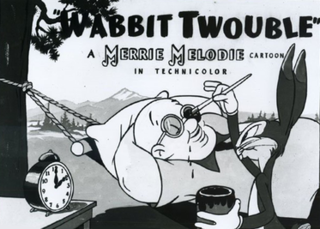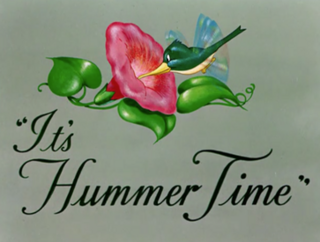Charlie Dog is an animated cartoon character in the Warner Brothers Looney Tunes series of cartoons. The character was featured in nine cartoons between 1941 and 1958. He is generally characterized as a friendly wise guy.

Tweetie Pie is a 1947 Warner Bros. Merrie Melodies cartoon directed by Friz Freleng. The short was released on May 3, 1947, and stars Tweety with Sylvester, who is called "Thomas" in this cartoon.
Warner Bros. Cartoons, Inc. was an American animation studio, serving as the in-house animation division of Warner Bros. during the Golden Age of American animation. One of the most successful animation studios in American media history, it was primarily responsible for the Looney Tunes and Merrie Melodies series of animated short films. The characters featured in these cartoons, including Bugs Bunny, Daffy Duck, and Porky Pig, are among the most famous and recognizable characters in the world. Many of the creative staff members at the studio, including directors and animators such as Chuck Jones, Friz Freleng, Robert McKimson, Tex Avery, Robert Clampett, Arthur Davis, and Frank Tashlin, are considered major figures in the art and history of traditional animation.

Wabbit Twouble is a Merrie Melodies cartoon starring Bugs Bunny, produced by Leon Schlesinger Productions and released on December 20, 1941, by Warner Bros. Pictures.

Babbit and Catstello are fictional characters, based on the comedic duo Abbott and Costello, that appeared in Warner Bros. animated cartoons. The characters appeared in four cartoons between 1942 and 1946: once as cats, once as dogs, and twice as mice.

A Corny Concerto is a 1943 Warner Bros. Merrie Melodies directed by Bob Clampett. The short was released on September 25, 1943, and stars Bugs Bunny, Porky Pig, Elmer Fudd and Daffy Duck.

The Old Grey Hare is a 1944 Merrie Melodies cartoon directed by Bob Clampett. The short was released on October 28, 1944, and features Bugs Bunny and Elmer Fudd, voiced by Mel Blanc and Arthur Q. Bryan respectively.

Hare Remover is a Merrie Melodies cartoon starring Bugs Bunny and Elmer Fudd, released in 1946. The film was the second Bugs Bunny cartoon to be directed by Frank Tashlin, the first being The Unruly Hare (1945). It was also the last short Tashlin directed before leaving Warner Bros. in 1944 to direct live-action films. His animation unit was handed over to Robert McKimson upon his departure.

The Wacky Wabbit is a 1942 Merrie Melodies cartoon directed by Bob Clampett. It stars Bugs Bunny and Elmer Fudd.
This is a list of all cartoons featuring Porky Pig. Directors are listed in parentheses.

A Pest in the House is a Merrie Melodies animated short film released on August 2, 1947. It is directed by Chuck Jones and stars the characters of Daffy Duck and Elmer Fudd.

Birth of a Notion is a 1947 Warner Bros. Looney Tunes cartoon directed by Bob Clampett and Robert McKimson. The cartoon was released on April 12, 1947, and stars Daffy Duck.

A Horse Fly Fleas is a 1947 Warner Bros. Looney Tunes cartoon short. It was written by Warren Foster and directed by Robert McKimson. The short was released on December 13, 1947.

The Hep Cat is a 1942 Warner Bros. Looney Tunes cartoon directed by Bob Clampett, written by Warren Foster, animated primarily by Robert McKimson, and set to a musical score composed by Carl W. Stalling. The short was released on October 3, 1942. This cartoon was the first Technicolor Looney Tunes short.

Nutty News is a 1942 Warner Bros. Looney Tunes cartoon directed by Bob Clampett. The short was released on May 23, 1942. Elmer Fudd's voice can be heard as the unseen narrator.
Don't Axe Me is a 1958 Warner Bros. Merrie Melodies cartoon directed by Robert McKimson. The short was released on January 4, 1958, and stars Daffy Duck, Elmer Fudd and Barnyard Dawg.
Wise Quackers is a 1949 Warner Bros. Looney Tunes cartoon directed by Friz Freleng. The film was released on January 1, 1949, and stars Daffy Duck and Elmer Fudd.

A Mutt in a Rut is a 1959 Warner Bros. Looney Tunes animated short directed by Robert McKimson. The short was released on May 23, 1959 and features Elmer Fudd.

It's Hummer Time is a 1950 Warner Bros. Looney Tunes cartoon directed by Robert McKimson and written by Warren Foster. The short was released on July 22, 1950. The cartoon stars a tuxedo cat who attempts to catch a hummingbird, only to get in the way of a bulldog who subjects him to various forms of torture for accidentally hurting and bugging him while doing so to the tune of Raymond Scott's Powerhouse, the cat seeming to know what's in store for him each time. All voice characterizations are performed by Mel Blanc.














